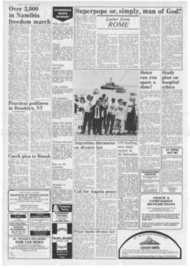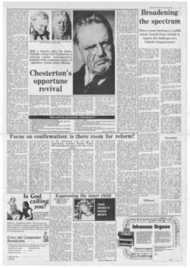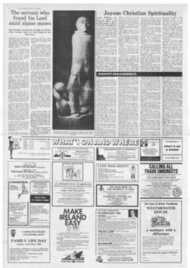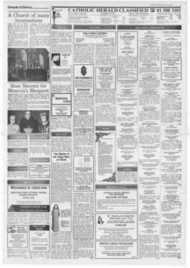Page 6, 6th June 1986
Page 6
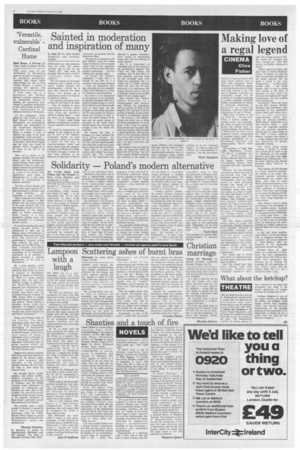
Report an error
Noticed an error on this page?If you've noticed an error in this article please click here to report it.
Tags
Share
Related articles
Adviser Is Mourned
Cardinal Hosts Launch Of Hume Biography
Hume Chair Bethlehem University Is To
Church Contemplates Cardinal's Cause
Dr Hume Of The Holy Sepulchre
`Versatile, vulnerable' Cardinal Hume
Basil Hume: A Portrait Ed Tony Castle (Collins, £9.95).
THE early years of any Archbishop of Westminster must be devoted to the legacy of his immediate predecessor. Cardinal Basil Hume rightly acknowledges his debt to John Carmel Heenan, a prelate of courage and capacity who placed buoys at the extremities of 'what some saw as a permissive tide. Without Heenan's constant vigilance and his remarkable tenacity in clearing the unresolved postVatican II problems bequeathed to him, Basil Hume would have been handicapped by an immense backlog of difficulties.
In this symposium, deftly edited by Tony Castle to mark Basil Hume's first decade at Westminster, the extraordinary versatility and vulnerability of this Ampleforth Benedictine shine forth. After a Heenan a Hume is needed, if only to chamfer the edges of the more triumphalist curial emissions but in a characteristic comment to the editor, Basil Hume hoped that his tenth year would be ignored "while I struggle on to be better at my job in the eleventh".
Here one is drawn to the uncanny parallels between Basil Hume and his predecessor, Arthur Hinsley. Each sought the priesthood from an early age, neither wanted the archbishopric of Westminster, both accepted it as a cross to be carried under obedience; each came to Westminster as a free man, devoid of ecclesiastical or political ambition.
The lives of both Hinsley and Hume have been marked by a deep spirituality; in Hume's case it seems effortless . . . but spirituality is never effortless.
Mary Craig and John Harriot examine the essence of Basil Hume's life; his French mother lit his early domestic life with that limpid certainty of faith so characteristic of the highest peaks of French spirituality. Hugo Young, in a most thoughtful closing essay, sets this spirituality in a national, secular context.
It is worth recalling that Basil Hume became Abbot of Ampleforth in 1963, just as Heenan came to Westminster as archbishop. Each man was faced with the spiritual and psychological traumas arising from renewal; the scale was different, but for Basil Hume, as Dorn Columba Cary-Elwes explains, the experience of quiet counselling in his Benedictine community in so turbulent a period provided a valuable introduction to his work at Westminster.
By a great paradox, which Chesterton would have cherished, Basil Hume has come to maturity at Westminster during the papacy of John Paul II. There is a great contrast between these two men, and Clifford Longley, in alluding to the Hume-Worlock axis, describes how Westminster and Liverpool returned empty handed from Rome after the Liverpool Pastoral Congress of 1980, having failed to change papal thinking on contraception and divorce. Hume learned a valuable lesson from this encounter, In Longley's words: "It was not enough to be right. To gain your point in Rome you also had to be political."
Hume and Wojtyla meet on the Vistula. The most centralising pope since Pius XI and the most centrifugal Archbishop of Westminster since 1850 find common ground in central Europe. Chris Cviic is very aware of Hume's influential work as President of the European Council of Episcopal Conferences and the great esteem which the European bishops show towards this self-effacing monk.
Despite their diverse outlooks Basil Hume and John Paul II are needed by the Church today; even more necessary, and welcome, is the growing empathy between the two men, not least in their desire for Church Unity.
But Douglas Brown lucidly explains, and indeed justifies, Hume's avoidance of the embraces of the British Council of Churches and the World Council; severe differences of principle on euthanasia and abortion are only part of the problem. Yet, any one of us with Anglican friends can pay witness to the magnetic attraction of Basil Hume's spirituality across denominational boundaries.
This excellent book is aptly termed A Portrait; it cannot be more than a provisional assessment until the Public Record Office begins to reveal the relationship between the two Westminsters, secular and ecclesiastical.
Thomas Moloney
Dr Moloney is author of Westminster, Whitehall and the Vatican: The Role of Cardinal Hinsley 1935-1943.
blog comments powered by Disqus



